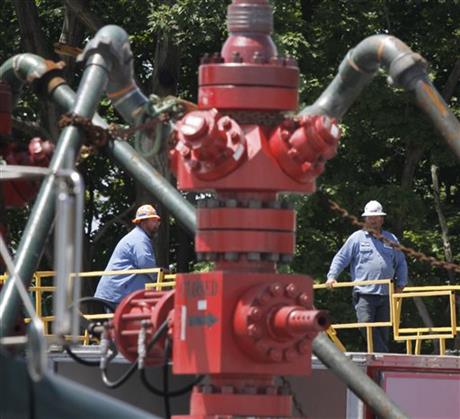
www.61a.162.myftpupload.com ,Cascade Media Group, The Game Changer, News, Kansas City, The Wave of the future, Whats Up Kansas City, latest news, Exclusive, twitter @whatsupkansascity, Carlos Nelson, Instagram@ cascademediagroup, CMG
By KEVIN BEGOS
FILE – In this July 27, 2011 file photo, workers stand behind the top of a pump for the hydraulic fracturing process in the Marcellus Shale layer to release natural gas at a Range Resources site in Claysville, Pa. A project examining the local health impacts from natural gas drilling challenge the industry position that no one suffers, but also suggest the problems may not be as widespread as some critics claim. (AP Photo/Keith Srakocic, File)
PITTSBURGH (AP) — A project examining the local health impacts from natural gas drilling is providing some of the first preliminary numbers about people who may be affected, and the results challenge the industry position that no one suffers but also suggest the problems may not be as widespread as some critics claim.
The Southwest Pennsylvania Environmental Health Project has been trying to help people who feel they’ve been sickened by natural gas drilling or processing for about 18 months in one county south of Pittsburgh.
The work is potentially important because it’s one of the first long-term attempts to monitor drilling-related health impacts, and it could help other groups identify possible symptoms.
The project found 27 cases where people in Washington County believe they were hurt by nearby drilling — seven cases of skin rashes, four of eye irritation, 13 of breathing problems and three of headaches and dizziness. The skin exposures were from water and the other cases were from air. The numbers don’t represent a full survey of the area, just cases so far with plausible exposures.
The EHP group is trying to help those who have been exposed to drilling-related air or water pollution, toxicologist David Brown told The Associated Press, adding that they’re finding “an array of symptoms” in some people who live close to either wells or processing stations.
There are some surprises: Air pollution seems to be more of a threat than water pollution, and the huge processing stations that push gas into national pipelines may be more of a problem than the drilling sites themselves. The processing stations can handle large volumes of gas from hundreds of wells.
Washington County has a population of about 200,000, and about 700 natural gas wells have been drilled there in the past six years. It’s also home to large gas processing operations.
Some experts not involved with the findings praised the general program but said the debate over fracking and health often neglects a crucial point.
“There’s a strong case that people in the U.S. are already leading longer lives as a consequence of the fracking revolution,” said Michael Greenstone, a professor of environmental economics at the Massachusetts Institute of Technology. That’s because many power plants have stopped burning coal and switched to natural gas, which emits far less fine soot, nitrous oxide and sulfur dioxide.
“Obviously, that has to be counterbalanced against the local effects of the drilling,” and that makes for a complicated decision, said Greenstone, formerly one of President Barack Obama’s chief economic advisers. Obama has expressed strong support for the natural gas drilling boom and has said it can be done safely.
Greenstone said more work needs to be done to confirm that Washington County residents were affected by natural gas activity and not by other factors, but he called the project an “important start.”
The EHP group only counted cases where symptoms began after natural gas activity started, where there was a plausible source of exposure and where the individual didn’t have an underlying medical condition that was likely to have caused the symptoms.
Brown said the project team is aware more work needs to be done on links between natural gas activities and health impacts. He said the work has been “a lot harder than I thought it was going to be,” but they’ve made substantial progress.
The work is preliminary, but there are other independent signs of problems related to the gas industry in Washington County.
John Poister, spokesman for the Departmental of Environmental Protection, said last week that the agency has ordered natural gas company MarkWest Energy Partners to submit a pollution control plan for one plant and would like to see the improvements “sooner rather than later.”
MarkWest environmental manager Nathan Wheldon said that protecting the environment of communities is a top priority and that the company operations meet or exceed all applicable state and federal regulations.
MarkWest, based in Denver, operates large natural gas facilities. A previous DEP report found some of the state’s highest levels of gas drilling air pollution in Washington County, including toxic compounds such as benzene, toluene and formaldehyde. Other gas drilling firms and companies operate in the area, too.
Long-term exposure to benzene can affect the immune system and cause cancer, while toluene can cause excessive sleepiness, confusion and, with long-term exposure, brain damage.
Patrick Creighton, a spokesman for the Marcellus Shale Coalition, an energy industry group, said, “Air quality across our region, and the nation, is sharply improving thanks to expanded natural gas use.”
Brown said one of the most worrying findings was the extremely high levels of air pollution found inside two homes that are about 1,000 feet from a gas processing station. Western Pennsylvania tends to have high levels of air pollution, but the levels found in the two homes were up to four times higher than the local average.
Brown said the group is collecting more data and pushing ahead to refine ways to advise people who are worried about nearby natural gas activity



